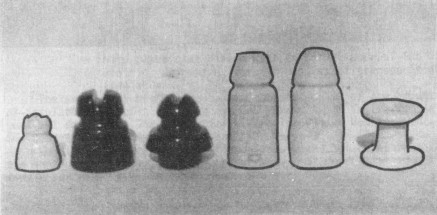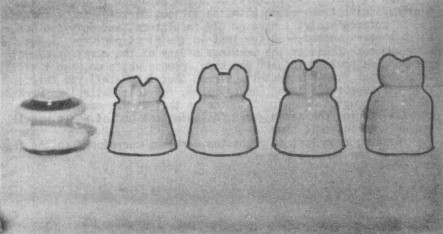Foreign Insulators
by Marilyn Albers
Reprinted from "INSULATORS - Crown Jewels of the Wire", April 1980, page 8
NGK Insulators Ltd. - Japan
NGK Insulators Ltd. began in 1919
with the establishment of its first factory in Mizuho, Nagoya, Japan. The
largest plant and main office still remain here, but since then three other NGK
factories have been put into operation. These three are (1) the Atsuta factory
in Atsuta, Nagoya, (2) the Chita factory in Handa, Aichi, and (3) the Komaki
factory in Komacki, Aichi. Permit me to untangle all those words!
All of Japan
is divided into a total of eight districts, of which Chubu is one. All four
factories are located along Japan's Pacific coastal strip in the district of
Chubu. Each district is further divided into political subdivisions called
prefectures. Mizuho and Atsuta are cities located in the prefecture of Nagoya
(named after its principal city, Nagoya, which also happens to be the
prefecture's government seat -- like New York, N.Y.) Handa and Komaki are cities
in the prefecture of Aichi.
NGK also has overseas offices located in Bombay,
India, Hamburg, Germany, and New York, U.S.A., with sales agents in all major
territories. Their insulators are presently in service in over eighty countries,
and their catalogue shows beautiful colored pictures of insulators on
transmission lines in India, Sweden, Finland, Norway, Italy, Australia, New
Zealand, Canada and the U.S.A. The list of items they produce is endless.
BUSINESS ITEMS
- PORCELAIN INSULATORS
- Suspension Insulators
- Long-Rod Insulators
-
High-Voltage Pin Type Insulators
- Line Post Insulators
- Cap and Pin Type Switch
and Bus Insulators
- Station Post Type Switch and Bus Insulators
- Indoor Switch and
Bus Insulators
- Apparatus Bushings
- Apparatus Porcelain Shells
- Fuse Cutouts and
Fuse Links
- Insulators for Railway Electrification (AC, DC)
- Telephone Insulators
-
Low-Voltage Insulators
- Others
- RESIN INSULATORS
- LINE HARDWARE
- MIRACLON (GLASS
CERAMICS) PRODUCTS
- MALLEABLE CAST IRON PRODUCTS
- CHEMICAL PORCELAIN PRODUCTS
-
BERYLLIUM PRODUCTS
- LIVE-LINE INSULATOR WASHING APPARATUS
- INSULATOR FACTORY
PLANNING & TECHNICAL CONSULTATION
- CERAMIC INDUSTRIAL MACHINERY AND EQUIPMENT
NGK is very proud in claiming vast resources of highest quality raw
materials, up to date manufacturing facilities, constant and advanced research
which keeps stride with the world's progress in technical developments of the
electrical industry.
The larger NGK insulators are very similar to the ones
produced by OTK, Osaka, Japan, so no real purpose would be served by including
drawings of these designs here, since they appeared in the last article on Japan
-- February '80 issue of Crown Jewels. However, the section in the NGK
catalogue on telephone and small pin type insulators did offer quite a bit of
variation, so I felt they would be of interest. The pin holes on these can be
made either according to the American Standard size or the smaller European
size. If the European size, then the insulator is usually meant to be secured to
a metal pin using hemp yarn thread. (They hasten to add that they do not supply
the hemp yarn!) All NGK insulators are porcelain -- no glass -- and the colors of
the glaze will be dark brown, bluish grey or white.

The insulators will always
bear the mark shown at the left. NGK insulators
The
following two pictures show the Japanese insulators in my personal collection,
along with the various markings to be found on them. Unfortunately, I have no
OTK insulators, and only one NGK, which appears second from the left in the
first picture. I don't know who made these or the meanings of any of the
markings except the NGK, do you? Help! If you know, please write me, and I will
include your findings in this column. But I can tell you this: When a Japanese
insulator (or any item, for that matter) is marked "Made in Occupied
Japan", it indicates that it was manufactured sometime during the seven
years following the end of World War II, and only during that time.
Reading from
left to right the markings correspond to the insulators in the first picture.


On
the following page are the markings to be found on the insulators in the second
picture -- again reading from left to right.


|
